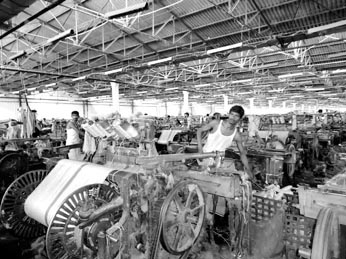
A historical sketch of our jute industry
Sarwar Md Saifullah Khaled | Saturday, 29 March 2014

Bangladesh industrial economy gained 65 per cent of the capacity owned and managed by the Pakistanis after the liberation war. This caused serious management problems in addition to a loss of an estimated Tk.69.9 million in the jute sector alone due to post-war damages and pilferages. It was a serious challenge before the Bangladesh government to restore normalcy in the economy and bring the production level to the post liberation period. For this purpose, the government of Bangladesh nationalised all abandoned mills and factories and also took over the Bengali owned mills and factories. This was a new experiment against a new national setting and the result was not happy.
In 1972-1973 the Jute Mills Corporation suffered a loss of Tk 255 million for a variety of reasons. It started with denuded stocks and inventories and a negative bank balance. It needed over Tk 1.1 billion and never got more than Tk 500 million. Out of its foreign exchange requirements of over Tk 170 million, it received only Tk 40 million or less than 25 per cent. About 15 per cent of the 160,000 odd workers employed on their own terms made the life of the officers miserable by agitation, gheraos and so on. Frequent power failures caused production loss of Tk 165 million and debarred two mills with 750 looms from going into production. Another Tk 100 million might have been lost due to labour unrests. Goods sold could not be shipped for want of tugs, barges and shipping space. Insurance claims of about Tk 112 million could not be received. The BJMC had to hire BIWTC barges at about 100 per cent premium at fixed rates. Despite being a government sales agent it could not adopt the policy of price maneuverability so common in international deals. And besides, it was going without the support of market studies or product development research.
As a consequence, the jute industry of Bangladesh dwindled. One striking feature of the jute industry before the liberation was continuous upward trends, but after liberation, the monthly production trends became very unstable. According to the Planning Commission, the installed capacity of the jute industry in 1972-73 was 792,000 tons, against which only 446,308 tons were actually produced in that year. This represented 56.35 per cent of the capacity utilisation as against 74.18 per cent in 1969-70. This slow recovery had been due to several causes emanating from war dislocations, post-war pilferages and abrupt changes in industrial and commercial policies, besides organisational and management in competencies during that period.
The falling trend in jute industry could not be recovered in the successive decades to reach or exceed the pre-liberation trends in jute productions. Rather the trend ran from bad to worse, which means the erosion in the jute economy in particular and the Bangladesh economy in general, started since the very birth of the Bangladesh. Even though we branded our economy as war devastated, the fact is, all our factories were intact up to December 16, 1971. The materials that disappeared from the factories are incidences of post liberation period. Though all the machineries and equipment were intact, production could not continue because of the lack of skilled managerial hands.
Soon after the assumption of power in 1982, the then government announced the Industrial Policy in June 1982, whereby it committed itself to a programme of large-scale disinvestment of public sector manufacturing industries. Following the denationalisation of 1982-1983, production fell by some 3.5 per cent in 1983-1984 in the private sector mills. In the same year, production fell by around 5.5 per cent in the 33 state retained mills, thus indicating that while production, in general, maintained its decline after 1982-1983, the denationalised mills performed slightly better than their public sector counterparts. As regards financial positions, in 1984-1985 all mills in both the sectors suffered huge losses, the losses in the private sector being a bit lesser. Such losses in subsequent years culminated in the eventual shutting down of Adamjee Jute Mills, the nation's and the world's biggest jute mills, along with some others.
Thus the jute industry of Bangladesh suffered heavily in the post-independence period. The scarcity and increased money supply caused a spiraling rise in the price of rice which necessitated increased acreage under paddy production causing a heavy toll of jute acreage. On the other hand, international demand for jute fell to a large extent due to heavy inroads made by synthetics into the jute products market. Opinions favouring the phasing out of the jute sector gained momentum in view of the overall grim picture of this sector. The fact is that despite the mounting problems in the jute sector, it had an edge over rice in terms of profitability even under the circumstances of 1973-1974 and 1974-1975.
In the first three years after independence, while Bangladesh jute industry had been struggling for survival, the Indian jute industry not only checked the decline and consolidated its position, but also significantly improved its performance. Not only that, India is going for rapid expansion, because the demand for jute goods has been rising rapidly at home and abroad because of environment-friendliness of jute and jute products.
The picture in our case is pathetic. Jute mills are being sealed off one after another on the plea of their being losing concerns as the government could not fulfill the conditions of the foreign donors. It is surprising that an independent country could not sustain the success of its jute industry, fed by hundred per cent indigenous raw materials, because of faulty foreign advice, negligence, mismanagement and unbridled corruption. It is of urgent importance to give proper attention to see that the jute industry may rejuvenate now.
The writer is a retired professor of Economics.
sarwarmdskhaled@gmail.com